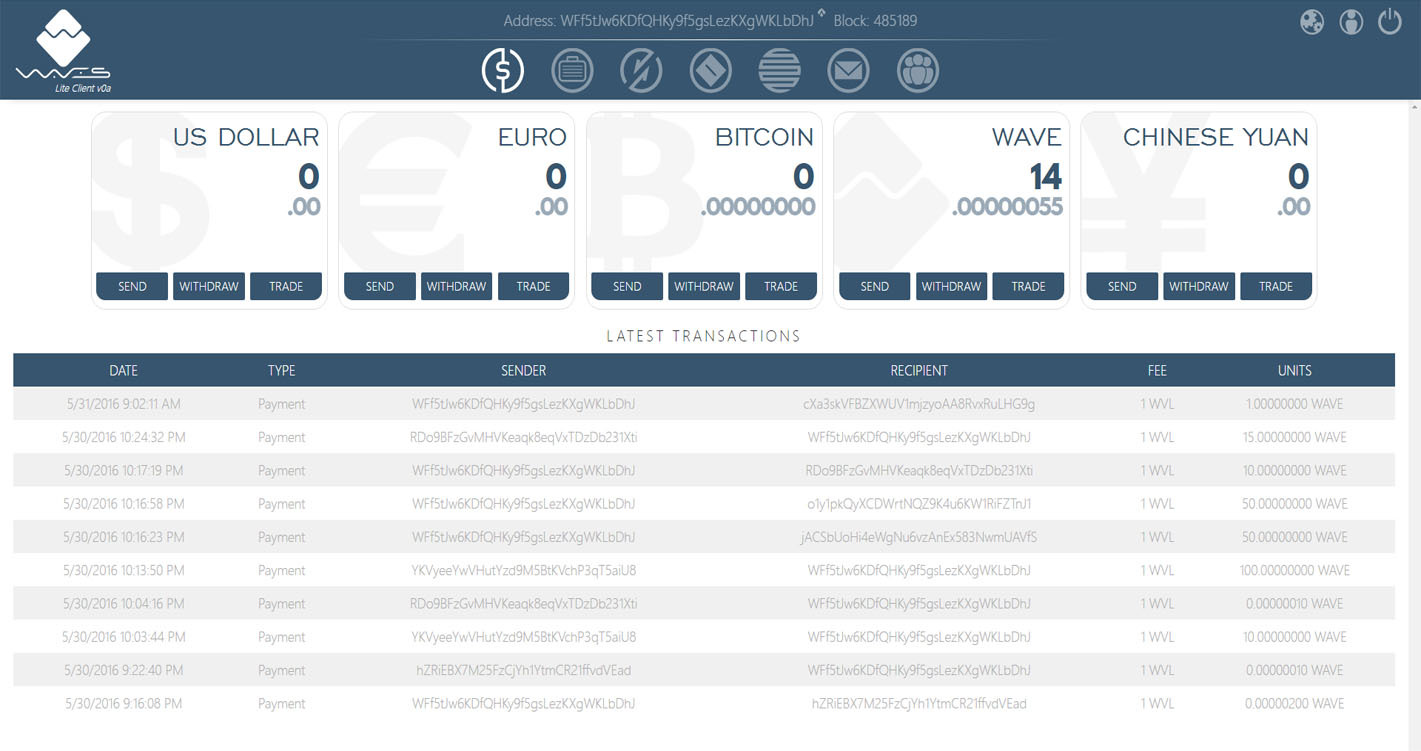Overview of decentralized crypto platforms. Part 1: Waves
 With this post I would like to open the cycle of reviews of blockchain platforms, the main purpose of which is to tell about the possibilities of practical application of the blockchain technology for building not only individual services, but also entire digital ecosystems. In our reviews, we will talk about systems that are undeservedly deprived of attention on Habré, but are widely known and discussed in a cryptocurrency crowd.
With this post I would like to open the cycle of reviews of blockchain platforms, the main purpose of which is to tell about the possibilities of practical application of the blockchain technology for building not only individual services, but also entire digital ecosystems. In our reviews, we will talk about systems that are undeservedly deprived of attention on Habré, but are widely known and discussed in a cryptocurrency crowd.The first material of the cycle focuses on the open source Waves blockchain platform, which by June of this year managed to attract funding in the amount of 29,445 BTC as part of the crowdfunding campaign, which was more than $ 15 million according to the exchange rate at that time.
I decided to learn more about the functionality of this decentralized platform, specializing in the blockchain-token model, its main activities, as well as the strategic steps of the project management.
')
Unlike the Canadian-based Ethereum team core and the German Lisk team, the backbone of the Waves team operates in Moscow.
The founder of the platform, Sasha Ivanov, graduated from the Department of Theoretical Physics at Moscow State University. Before diving into a cryptocurrency environment, he specialized for several years in the development of bots for trading on the exchange based on the model of artificial neural networks.
Prior to the implementation of the project, Waves Ivanov managed to launch the Coinomat cryptocurrency instant exchange service, develop the first crypto fiat token CoinUSD, and together with several notable blockchain-enthusiasts founded the Crypto Asset Fund - a venture fund specializing in blockchain technology.
During the period of cryptocurrency development, the founder of Waves drew on the potential of blockchain technology for issuing securities and crowdinvesting. One of the projects that influenced the formation of Waves was the blockchain-platform NXT — one of the first platforms that gave users the opportunity to create their own crypto analogs of stocks — blockchain-tokens — and trade them on the stock exchange, thus attracting investments. Whitepaper Waves also shows references to the NXT experience, which was taken into account when developing its own platform.
Crowd investing on the blockchain has a number of advantages compared with the classic models of venture investment and crowdfunding.
Thus, instead of working under the patronage and observing the conditions of one large venture capital investor, the project founders may find themselves in a much more interesting way in which the funds for the project are attracted due to a large amount of microinvestment. In addition, in addition to receiving funding, start-ups automatically have the opportunity to form a primary user base capable of testing a particular project within the framework of the crowd-investing community established as a result of the campaign. It is likely that Direct Investment will gradually bite off its chunk of the market from venture capital funds.
As for the classical model of crowdfunding, in contrast, for example, from the popular international crowdfunding platform Kickstarter, Waves will allow you to withdraw from the project investors by selling your token on the stock exchange to another user, without waiting for the final results of the project.
Waves is a platform whose functionality enables users to issue custom tokens, which will be equivalent to some assets, perform various operations with them, as well as implement such directions as trading, exchanging Fiat and cryptocurrency, voting on blockchain and decentralized crowdfunding.
As part of the crowdfunding campaign on Waves, start-ups can issue crypto-tokens, the purchasers of which, in turn, have the opportunity to operate with them at their discretion: to buy, sell, transfer or exchange without intermediaries. And all this on the principles and technologies of the blockchain.
For all the above operations with tokens, a special p2p-exchange is created within the Waves platform. It can be said that tokens play the role of some kind of universal tool, which, depending on its purpose, is tied to one or another asset.
This mechanism is implemented as follows: using the network gateways that support the token, it is confirmed to be linked to a particular currency, for example, the US dollar. Unlike the tokens of the BitShares decentralized exchange platform (which is based on a dynamic mechanism operating through scripts, where, in order to make sure that the cost of the token remains tied to the asset, the bots automatically execute the purchase and sale transaction on the exchange), Waves platform assumes the use of blockchain payment systems as a transaction layer.
In order for the participants of the crowdfunding project to decide how to distribute profits or what to spend the funds raised, Waves plans to implement a voting system based on blockchain technology.
To enable the transition from NXT to Waves, the development team is planning to launch a protocol that allows you to transform the assets of a project hosted on the NXT platform into Waves assets.
In addition to the advantages of the blockchain model, Waves also implies a number of certain risks that can be divided into three categories:
- Technical risks, for example, bugs that cause a loss in the cost of a token, as is the case with Ethereum. This type of risk lies on the Waves platform itself.
- Risks of fraud, which can be reduced due to the KYC-assessment system of projects located on the site. It is fair to say that during the ICO and crowdsales cryptocurrency projects there were almost no cases of successful fraud, as investors trust their money only to well-known people from the industry who have a positive reputation.
- Legal risks, in order to avoid which a competent assessment of the compliance of the model with the existing state legislation is necessary. For example, in the USA there is a very strict policy regarding crowdinvesting, but at the same time in Asia and Europe it is possible to choose more favorable jurisdiction for a project of this type.
From a legal point of view, Waves crypto tokens are implemented as a digital product and cannot be equated with securities or shares in a business. In fact, the token is tied to the value of certain products within the system. Thus, tokens can simultaneously maintain control over the company and satisfy the interests of investors.
In order to start working with Waves, users are prompted to install the Lite Client . Lite Client does not assume the installation of the full Waves blockchain and stores only information about the user's own assets within the framework of the platform.

In addition, server software is offered for sites with a full blockchain.
The Waves platform started with the code of the Scorex framework, an open source blockchain project that its creators say can accelerate the research and development processes in the field of cryptocurrency and blockchain. This is largely explained by the compactness of the Scala code at the heart of Scorex. For comparison: the Bitcoin Core code contains more than 100,000 lines of code, NXT contains more than 45,000 Java codes, and in both of them, in another project, the code structures are quite confusing, which somewhat reduces the space for developers to experiment with. At the same time, Scala Code Scorex consists of less than 4,000 lines of code.
Mining platform Waves is based on the consensus Leased Proof of Stake (LPoS). This type of consensus allows you to create blocks in 10 seconds due to the limited number of nodes (about 100). LPoS provides users with the opportunity to lend their balance to other nodes in exchange for a portion of the profits, unlike the consensus of the Bitshares DPoS (Delegated Proof of Stake) platform, where the miners are determined by simple voting.
According to the founder of Waves, LPOS consensus implies a system in which users who generate blocks are selected by the Waves token balance. In this case, users at any time can withdraw their funds and send them at their discretion. But ordinary users cannot use the money for mining, they can only transfer them to the generators in exchange for a reward. This approach is called “account leasing”.
Not long ago, a rewards program was announced, under which tester enthusiasts created a test network of 100 full nodes. The purpose of this step is to test the operation of the LPoS consensus protocol and to monitor the transactions carried out through the Waves network. In case of positive test results, participants in the next stage of the program will try to find platform vulnerabilities and break the system. Participant motivation is a bonus for the result determined by the Waves development team depending on the stage of this testing.
After some time, smart contracts are planned to be added to the platform, which will be launched only on full nodes to achieve greater scalability. Given the unfortunate experience of The DAO, within the framework of Waves, the plan is to implement a less flexible one compared to Ethereum, but a safer solution - transactions will not be carried out through smart contracts, but will take place inside the sandbox. This program works in a protected environment and, in fact, has no access to anything - neither to resources within the system, nor to external resources. Unlike the Ethereum code, which functions independently of the developers, the sandbox receives data through some communication channels, processes them and gives them away. This is the usual approach of virtual machines.
The results of the code in the sandbox will be available to all developers. Unlike Ethereum, Waves code will not be integrated with the blockchain. The Waves code will be in the Sandbox, where calculations will be made. The code will work on several nodes whose indicators can be compared. Third-party developers will be offered an API for implementing contracts in any programming language.
The platform will allow to develop an additional password system ( 2FA ) on the blockchain. Unlike other systems, where the risk of theft of the password database is preserved, the security of each password in the Waves authentication system provides distributed technologies and cryptography. Users of sites integrated with the 2FA-solution of Waves will be able to authenticate using a password stored in a decentralized system, eliminating the risk of a password being changed by an attacker.
Unlike the Ethereum platform, whose founder Vitaly Buterin initially recognized the experimental tasks of his development, the Waves platform aims to solve specific business problems with a large load and the ability to scale.
Sources on GitHub - github.com/WAVESPLATFORM
Discussion on Bitcointalk - bitcointalk.org/index.php?topic=1387944.0
In this review, we looked at the Waves blockchain platform as an example of the successful application of the concept of using crypto tokens. In the following review cycle material, we will look at the Lisk cryptoplatform, which offered its users the opportunity to develop JavaScript-based applications without having to master the language of the platform itself, as implemented in Ethereum.
Source: https://habr.com/ru/post/310082/
All Articles